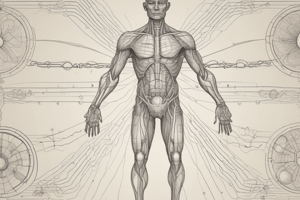Podcast
Questions and Answers
What is the primary function of the peripheral nervous system?
What is the primary function of the peripheral nervous system?
To transmit information to and from the central nervous system
What type of control system uses hormones to transmit information?
What type of control system uses hormones to transmit information?
Endocrine system
What is the term for a rapid, automatic response to a stimulus?
What is the term for a rapid, automatic response to a stimulus?
Reflex
What is the purpose of negative feedback mechanisms in maintaining homeostasis?
What is the purpose of negative feedback mechanisms in maintaining homeostasis?
What is the primary importance of control and coordination in an organism?
What is the primary importance of control and coordination in an organism?
Flashcards are hidden until you start studying
Study Notes
Control and Coordination
Control and coordination refer to the processes by which an organism responds to stimuli, maintains homeostasis, and regulates its internal environment.
Types of Control Systems:
- Nervous System: Fast responses to stimuli, uses electrical signals to transmit information
- Endocrine System: Slower responses, uses hormones to transmit information
- Muscular System: Voluntary and involuntary movements, responds to nervous system signals
Components of the Nervous System:
- Central Nervous System (CNS): Brain and spinal cord, integrates and processes information
- Peripheral Nervous System (PNS): Nerves, transmits information to and from CNS
- Sensory Nerves: Transmit information from sensors to CNS
- Motor Nerves: Transmit information from CNS to effectors
Reflexes:
- Reflex Arc: A rapid, automatic response to a stimulus
- Receptor: Detects stimulus
- Sensory Neuron: Transmits information to CNS
- Integration Center: Processes information
- Motor Neuron: Transmits information to effector
- Effector: Responds to stimulus (e.g., muscle contraction)
Coordination Mechanisms:
- Feedback Mechanisms: Monitor and adjust responses to maintain homeostasis
- Negative Feedback: Reduces response to maintain homeostasis
- Positive Feedback: Amplifies response to achieve a specific goal
- Hormone Regulation: Endocrine system regulates hormone production and secretion
Importance of Control and Coordination:
- Maintains Homeostasis: Regulates internal environment to maintain optimal conditions
- Responds to Stimuli: Enables organisms to adapt to changes in their environment
- Regulates Body Functions: Controls and coordinates various bodily functions, such as movement, growth, and development
Control and Coordination
- Control and coordination refer to the processes by which an organism responds to stimuli, maintains homeostasis, and regulates its internal environment.
Types of Control Systems
- Nervous system: fast responses to stimuli, uses electrical signals to transmit information.
- Endocrine system: slower responses, uses hormones to transmit information.
- Muscular system: voluntary and involuntary movements, responds to nervous system signals.
Components of the Nervous System
Central Nervous System (CNS)
- Brain and spinal cord, integrates and processes information.
Peripheral Nervous System (PNS)
- Nerves, transmits information to and from CNS.
- Sensory nerves: transmit information from sensors to CNS.
- Motor nerves: transmit information from CNS to effectors.
Reflexes
- Reflex arc: a rapid, automatic response to a stimulus.
- Receptor: detects stimulus.
- Sensory neuron: transmits information to CNS.
- Integration center: processes information.
- Motor neuron: transmits information to effector.
- Effector: responds to stimulus (e.g., muscle contraction).
Coordination Mechanisms
Feedback Mechanisms
- Monitor and adjust responses to maintain homeostasis.
- Negative feedback: reduces response to maintain homeostasis.
- Positive feedback: amplifies response to achieve a specific goal.
Hormone Regulation
- Endocrine system regulates hormone production and secretion.
Importance of Control and Coordination
- Maintains homeostasis: regulates internal environment to maintain optimal conditions.
- Responds to stimuli: enables organisms to adapt to changes in their environment.
- Regulates body functions: controls and coordinates various bodily functions, such as movement, growth, and development.
Studying That Suits You
Use AI to generate personalized quizzes and flashcards to suit your learning preferences.




